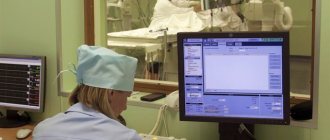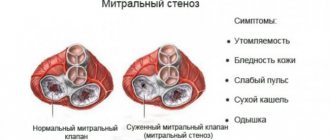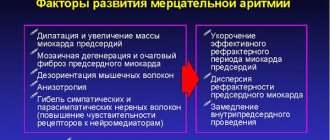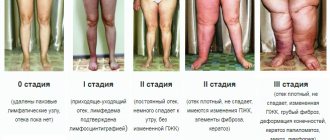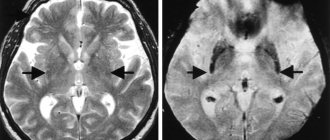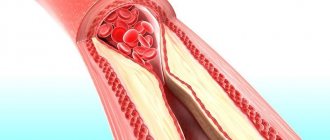Coronary heart disease, or IHD, occurs when there is poor blood supply to the heart muscle, resulting in damage to the myocardium. The pathology is widespread and is one of the main causes of death and disability in the world. The Alpha Health Center clinic in Moscow deals with the diagnosis and treatment of coronary heart disease, including chronic heart disease (HIHD). Equipping with modern equipment allows us to accurately determine the patient’s health status and prescribe the correct therapy.
Types of cardiac ischemia
- Angina (stable and unstable) is chest pain caused by a lack of oxygen supply to the myocardium.
- Myocardial infarction (primary, repeated) - partial or complete blockage of the artery through which blood flows to the heart.
- Post-infarction cardiosclerosis is the presence of parts of the heart that died during a heart attack and which were replaced by connective tissue.
- Heart failure is a violation of the pumping function of the heart, as a result of which the body does not receive sufficient oxygen supply.
- Sudden arrhythmic death is the death of a person within an hour after the onset of acute manifestations of the disease.
Causes of ischemia
Impaired supply to the heart muscle occurs due to:
- significant narrowing of the lumen of the arteries;
- spasms and damage to the coronary arteries;
- problems with microcirculation;
- changes in blood clotting.
The main cause of coronary heart disease is atherosclerosis, which develops due to the accumulation of cholesterol in the arteries. Plaques form on the walls, which grow and block the passage. Further, cracks and ruptures appear on the plaques, which leads to thrombus formation. As a result, the lumen narrows by 95%, the condition is accompanied by fatigue even at rest and is considered critical.
The main risk factors for developing coronary heart disease:
- male gender;
- age - adults over 40 years old;
- genetic predisposition;
- heavy smoking for more than 5 years;
- high cholesterol;
- unhealthy diet, obesity;
- diabetes;
- low mobility;
- long-term stress.
Possible factors for the occurrence of coronary heart disease include:
- problems with sleep patterns (breathing apnea);
- congenital arterial pathologies;
- coronary artery stenosis;
- elevated blood lipid levels;
- exceeding the norm of amino acids responsible for metabolism;
- chronic kidney diseases.
Symptoms
The main symptom of coronary heart disease is pressing pain behind the chest or in the heart area. It can radiate to the lower jaw, left shoulder, hand, back and neck. During the acute form, a heart attack or pre-infarction condition develops. In chronic ischemic heart disease, pain is felt during physical activity, and pain tolerance decreases over time.
Main features:
- burning, suffocating pain in the heart area;
- heaviness in the chest;
- feeling of uneven heart rate, heart palpitations;
- dyspnea;
- weakness, dizziness, fainting;
- sweating;
- nausea;
- soreness after physical activity;
- duration from 30 seconds to 15 minutes;
- high efficiency of nitroglycerin.
Fatigue sometimes goes away completely after stopping physical activity. If the patient has unstable angina or myocardial infarction, then there may be no complaints about the heart after exercise. On the contrary, they appear during rest and last a long time - up to several hours. Depending on the form of the pathology, a certain discomfort prevails.
If the described signs of coronary heart disease are detected, you must make an appointment with a cardiologist. If acute pain does not go away for more than 10 minutes, you should call an ambulance.
In this case, progressive ischemic heart disease can develop over several years. In some patients, there are no signs or symptoms are vague. To avoid severe complications and not to trigger the disease, it is necessary to undergo a comprehensive examination regularly, especially in adulthood.
To ensure the effectiveness of dietary therapy for patients with coronary artery disease, an energy balanced diet is necessary. Patients with normal body weight or some deficiency are prescribed a diet with a calorie content of 2900 kcal. If you are overweight, the calorie content of your diet should be reduced by limiting animal fats and carbohydrates, mainly refined ones, and bread. It is advisable to prescribe various contrast (fasting) days against the background of treatment with a diet that is appropriate in calorie content. The rhythm of nutrition is essential. Infrequent meals increase hyperlipidemia, impair carbohydrate tolerance and promote weight gain. The distribution of the diet throughout the day should be uniform, the number of meals should be 5 times a day.
Characteristics of the anti-atherosclerotic diet and its application
Indications for use. IHD, atherosclerosis of coronary, cerebral, peripheral vessels, hypertension stage II-III.
Special purpose. Help improve metabolic processes, blood circulation, restore metabolism of the vascular wall and heart muscle, reduce hemocoagulation of the blood, normalize nervous processes that regulate various functions of the body.
General characteristics. A diet limiting table salt and animal fat, replacing a significant amount of the latter with vegetable fat and including foods rich in cell membranes, lipotropic substances, ascorbic acid, vitamins P, group B (especially B6), potassium and magnesium salts. The diet includes seafood (marine invertebrates, seaweed), which have high biological value due to the rich content of organic compounds of iodine, manganese, zinc, as well as methionine and B vitamins.
Two diet options are recommended: the first is for people with excess body weight, the second is for people with normal or low body weight.
Culinary processing. All dishes are prepared without salt; meat and fish - boiled or baked.
Calorie content and chemical composition. The first diet option (table of an approximate one-day menu for people with excess body weight): proteins 90 g, fats 70 g (animal 35%), carbohydrates 300 g. Calorie content 2100-2200 kcal. The second diet option (table of an approximate one-day menu for people with normal or low body weight): proteins 100 g, fats 80 g, carbohydrates 350 g. Calorie content 2600-2900 kcal.
Mineral composition: table salt 3-5 g; calcium 0.5-0.8 g, phosphorus 1-1.6 g, magnesium 1 g. Content of vitamins C - 100 mg, B1 - 4 mg, B2 - 3 mg, PP - 15-30 mg, B6 - 3 mg .
The total weight of the diet is about 2 kg, free liquid is about 1 liter, the food temperature is normal. Number of meals - 6 times a day.
List of recommended products and dishes. Bread and bakery products. Bread without salt, yesterday's baking, coarsely ground rye and wheat, crackers, dry unsweetened cookies, crispbread. Bran bread with phosphatides.
Soups. Vegetarian, fruit, dairy, cereal. Prepared without salt.
Meat and poultry dishes. Lean meats, poultry (excludes internal organs of animals) boiled or baked (in pieces or chopped).
Fish dishes. Low-fat varieties boiled or baked.
Vegetable dishes and side dishes. All kinds, with the exception of vegetables with coarse fiber (radish, radish), spinach, sorrel. Raw vegetables in chopped form.
Fruits, berries, sweet dishes, sweets. Any ripe fruits, berries. Any juices (except grape). Sweets (sugar, jam) are limited to 50 g. Raw fruits with coarse fiber in crushed form.
Dishes and side dishes made from cereals, flour, pasta.
Flour and pasta products in limited quantities.
Various crumbly cereals, puddings, casseroles.
Eggs and dishes made from them. Soft-boiled eggs (2-3 per week), steamed egg white omelet.
Milk, dairy products and dishes made from them. Milk in its natural form and in dishes, kefir, yogurt, acidophilus. Fresh cottage cheese in its natural form and in dishes.
Fats. Vegetable oils for cooking and ready-made dishes (vinaigrettes, salads). Butter for cooking.
Beverages. Rosehip decoction, tea, tea with milk, weak coffee, fruit, berry, vegetable juices, kvass. Carbonated drinks are limited.
Snacks. Low-fat ham, doctor's sausage, unsalted and mild cheeses, vinaigrettes, salads with the addition of seaweed. Lightly salted herring (once a week).
Sauces. Dairy, vegetable broth, fruit and berry sauces.
It is recommended to include belip (a mixture of unleavened cottage cheese and raw crushed cod) in combination with bread, cereals and vegetable products in the anti-atherosclerotic diet. Shown are dishes from seaweed, squid, scallop, mussels, etc. d.
Prohibited: fatty meats, fish, strong meat broths, beef, lamb, pork fat, internal organs of animals, brains, caviar, lard, cream, baked goods, cream cakes, spicy, salty, fatty snacks, cocoa, chocolate, ice cream , alcoholic drinks.
For patients with coronary artery disease who are overweight and on a diet, it is recommended to prescribe fasting days once every 3-7-10 days: milk days (100 g of warmed milk 8 times a day), kefir days (a glass of kefir 5-6 times a day) and curd days (100 g of cottage cheese or cheesecakes, or cottage cheese casserole 4-5 times a day; in this case, add 100 g of kefir or milk to each serving of cottage cheese).
Diagnostics
At the initial appointment, the cardiologist collects anamnesis and clarifies the symptoms. Next, the patient is examined to identify edema and cyanosis of the integument. By listening, murmurs and heart rhythm disturbances are determined.
The next step is to take blood tests, including cholesterol and glucose levels. The greatest accuracy of diagnosis is provided by instrumental methods that allow you to determine the main signs of coronary heart disease.
Depending on the clinical picture, the doctor prescribes:
- electrocardiogram;
- ultrasonography;
- stress tests under load and with drug stimulation:
- Holter ECG;
- coronary angiography.
We have equipment for digital X-ray diagnostics and electrocardiography at our disposal. We perform a treadmill test to determine how the heart functions during physical activity. During the procedure, the person is asked to walk on a treadmill. After three minutes, increase the inclination and speed of movement. The equipment records blood pressure and ECG parameters, as well as blood oxygen saturation, and counts the heart rate. Using equipment, the body’s resistance to a certain intensity and duration of stress is determined. During the test, the functional diagnostics doctor monitors the patient’s condition and prevents overload.
Holter monitoring allows long-term recording of cardiac performance indicators. The device collects data throughout the day, under typical human conditions, due to which it helps to determine with high accuracy what exactly provokes an ischemic attack.
Based on the results obtained, the doctor can establish a connection between an acute attack of coronary artery disease and a person’s lifestyle, using data from the diary kept by the patient during the examination. One advantage is the ability to detect “silent” ischemia at night. 24-hour studies are also widely used to adjust treatment.
Timely diagnosis allows you to prevent consequences, deterioration and death from IHD. Screening is recommended for adults for preventive purposes, starting from the age of 20 every 4-6 years and more often (in old age).
Methods for diagnosing coronary heart disease
When examining a patient, the doctor determines which diagnostic methods are necessary in this particular case.
Diagnosis of IHD is carried out by cardiologists. To determine the condition of the heart, the following are used:
Blood chemistry
A biochemical blood test for ischemic heart disease includes indicators such as glucose, cholesterol, AST and ALT and cardiac-specific markers (troponin I, myoglobin, etc.).
More information about the diagnostic method
ECG
ECG is a basic diagnostic procedure in cardiology. But ECG data is often not enough. So, with angina pectoris, an ECG will show pathological changes only during an attack, and at rest such changes may be absent.
More information about the diagnostic method
Echocardiography
Echocardiography (EchoCG) for IHD is used to diagnose the disease, risk stratification and select a medical strategy in the case of already established IHD.
More information about the diagnostic method
To identify changes that cannot be detected during examination at rest (at a doctor’s appointment), Holter (24-hour) ECG monitoring can be used. Sensors are attached to the patient’s body, the information from which is sent to a portable device. The patient leads his usual lifestyle. The received data is then processed. In this way, cardiac abnormalities are detected.
Treadmill test
Exercise tests can help identify heart problems. In modern medicine, such varieties as the treadmill test (a treadmill is used) and bicycle ergometry (an exercise bike is used) are common.
More information about the diagnostic method
Coronary angiography
Coronary angiography allows you to study the patency of the coronary vessels and the degree of their changes.
More information about the diagnostic method
Sign up for diagnostics To accurately diagnose the disease, make an appointment with specialists from the Family Doctor network.
Treatment
The goal of therapy is to normalize blood supply and improve the quality of life of patients. Conservative and surgical treatment is used.
Drug treatment
The doctor prescribes a set of medications that help control the onset of symptoms and improve the prognosis for the development of chronic pathology.
Typically this is:
- antiplatelet agents - they reduce thrombus formation;
- B-blockers;
- calcium antagonists;
- nitrates;
- receptor blockers;
- statins to control cholesterol.
Surgery
Depending on the results of diagnosing coronary heart disease, the doctor may refer you to a hospital for:
- Myocardial revascularization with laser. The procedure restores blood flow to the heart;
- Installation of stents in coronary arteries. The operation is performed under local anesthesia through an artery in the forearm or groin. A stent is placed in the narrowed area of the vessel, which presses the plaque against the wall to restore patency;
- Coronary artery bypass surgery is an open-heart surgery to restore blood supply. The method involves changing the direction of blood flow past narrowed areas. The patient's veins and arteries serve as coronary bypass grafts.
The treatment strategy depends on the severity of the disease and health status. When choosing an approach, the doctor takes into account the risks for the patient for 10 years after treatment.
Preventive measures
Patients with coronary artery disease are advised to change their lifestyle:
- reduce weight in case of obesity;
- include active sports;
- adhere to proper nutrition;
- stop smoking;
- comply with night sleep standards.
Preventing the development of a disease is easier than treating it. To prevent narrowing of the arteries, doctors recommend monitoring blood pressure, reducing stress levels, and not triggering depression. It is necessary to reduce the consumption of alcohol, fried, fatty, smoked and salty foods. It is advisable to walk more, do exercise therapy, exercise, and swimming. Physical activity strengthens the walls of blood vessels and reduces the risk of weight gain.
An important measure for the prevention of coronary heart disease is regular visits to a cardiologist to prevent the development of pathological processes. In our center you can undergo all the necessary examinations and tests to determine the state of your cardiovascular system.
Prevention
Preventing a disease is much easier than curing it. To maintain healthy arteries and blood vessels, it is necessary to eliminate risk factors that negatively affect your health:
- To give up smoking;
- Monitoring blood pressure levels
- Normalization of the level of “bad” cholesterol (low-density lipoproteins)
- Fighting stress and depression
- Minimize alcohol consumption;
- Refusal of smoked, fatty, fried and salty foods.
Spend more time on an active lifestyle: moderate physical activity, therapeutic exercises, morning exercises, walking, swimming, dancing. Physical activity will help strengthen the walls of blood vessels and maintain normal weight, and if necessary, reduce it.
The most important thing in prevention is timely observation by a specialist. In order not to visit medical institutions several times to undergo all the necessary tests and examinations, contact our cardiology center. Federal Research Center FMBA offers patients several programs for comprehensive heart research. You can find them here.
